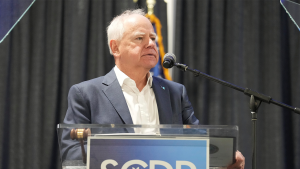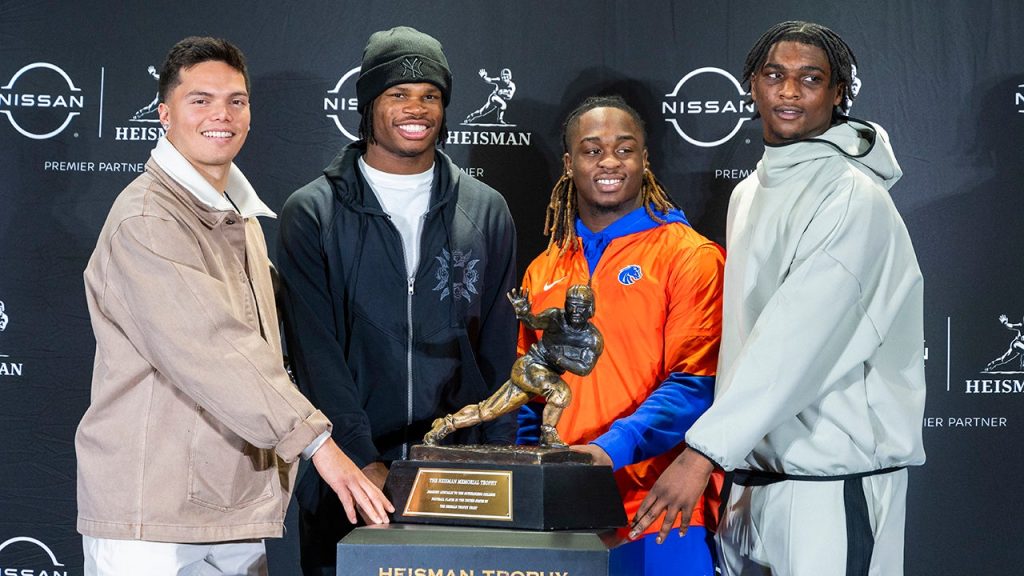Ashton Jeanty, a standout running back from Boise State University and a prominent contender for the prestigious Heisman Trophy, has captivated the college football world not only with his exceptional on-field prowess but also with a sartorial statement that resonated deeply with fans. Arriving in New York City for the 90th annual Heisman Trophy ceremony, Jeanty distinguished himself from his fellow finalists by choosing to represent his university through his attire, a decision that sparked widespread admiration and discussion on social media platforms. While other candidates opted for more conventional formal wear, Jeanty proudly donned an orange and blue tracksuit, the colors of the Boise State Broncos, underscoring his unwavering loyalty to the program that propelled him to national recognition.
Jeanty’s distinctive outfit choice quickly became a trending topic on social media, with fans and commentators praising his commitment to representing his school and the broader running back community. Many lauded his decision as a refreshing display of humility and a testament to his understanding that his achievements were not solely his own but were also a product of the support and opportunities provided by Boise State. This act of acknowledging his roots resonated particularly strongly with fans who appreciated Jeanty’s open expression of gratitude and his recognition of the collaborative nature of success in collegiate athletics. The tracksuit became a symbol of his connection to his team, his university, and the broader football community that had supported his journey.
When questioned about his decision to wear the tracksuit, Jeanty explained that while the Heisman guidelines encouraged wearing team gear, his choice was driven by a deeper sense of loyalty and appreciation for Boise State. He emphasized that he wouldn’t be in contention for the Heisman without the foundation provided by his university and felt a strong responsibility to represent the Broncos on this national stage. This sentiment further cemented his image as a grounded and appreciative athlete, qualities that resonated with fans who valued his humility and dedication. His decision served as a powerful reminder of the importance of institutional support in shaping individual success.
Beyond his attire, Jeanty’s remarkable season on the field solidified his position as a leading Heisman contender. Leading the nation with an impressive 2,497 rushing yards and 29 touchdowns, he breathed new life into the running back position, which has seen fewer Heisman finalists in recent years. Jeanty’s performance not only underscored his individual talent but also served as a powerful reminder of the continued importance of the running back in modern football. His success offered a counterpoint to the increasing emphasis on passing offenses in the contemporary game, reminding fans and analysts alike of the enduring impact a dominant running back can have on a team’s success.
Jeanty’s presence in New York also carried a broader significance, as he acknowledged the responsibility he felt to represent the running back community as a whole. Recognizing the relative scarcity of running backs among recent Heisman finalists, he viewed his candidacy as an opportunity to champion the position and honor the legacy of great running backs who may not have received the same level of national recognition. This perspective further elevated his status in the eyes of fans, who admired his humility and his willingness to carry the torch for his fellow running backs. His nomination became a symbol of the enduring importance of the position and a testament to the talent and dedication of running backs across the nation.
The culmination of Jeanty’s remarkable season and his unique approach to representing his university and position culminated in the highly anticipated Heisman Trophy ceremony. While the ultimate outcome remained uncertain, Jeanty’s impact on the college football landscape was undeniable. He had successfully captured the attention and admiration of fans nationwide, not only for his exceptional athleticism but also for his character, humility, and unwavering loyalty to his school and the running back community. His story served as an inspiring reminder of the power of dedication, gratitude, and the importance of recognizing the contributions of others in achieving individual success. His journey transcended the realm of athletic achievement, becoming a narrative about representing one’s community and honoring the legacy of those who came before.










